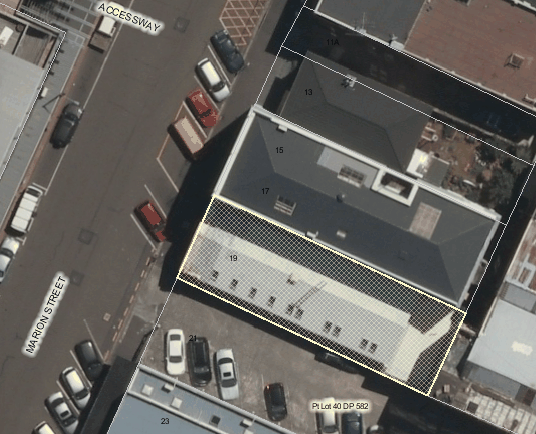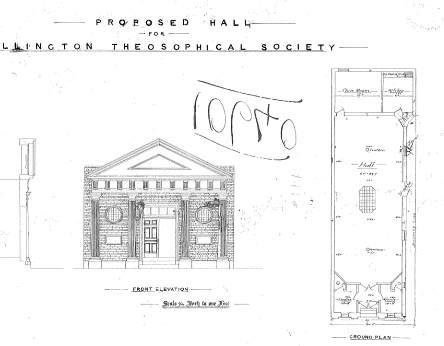Theosophical Society Hall
Theosophical Hall
-
Constructed
1918
-
-
Architect(s)
-
Builder(s)
Unknown
-
This hall has been used continuously since its construction in 1918 by the Theosophical Society, a spiritual movement which began in the United States in the late nineteenth century and was particularly popular in the early twentieth century.
The building’s Classical architecture gives it a distinctive appearance amongst the modern buildings of Marion Street.
The street façade is largely unchanged so the building has retained considerable authenticity.
-
Downloadable(s)
-
close
History
-
The Theosophical Society was founded in New York by Helen Blavatsky and Henry Steel Olcott in 1875. Theosophy was a movement which drew upon Spiritualism, Occultism and Western interpretations of Buddhism and Hinduism in order to create a universal religion. The appeal of the Theosophical Society to Victorians was that it claimed to consolidate the rift that existed between science and religion, thus making it a fitting movement to resolve the spiritual crisis of the post-industrial nineteenth century.
The first New Zealand lodge was founded by Toronto Sturdy (1860-1957) in Wellington in the late 1880s. There were some famous early adherents, among them Edward Tregear, administrator and Māori scholar, and Premier Harry Atkinson. In 1892 Henry Steel Olcott visited New Zealand and was received in Auckland.
The Wellington hall was first built in 1918. Since then the hall has been the venue for many lectures and society activities. Society numbers waned somewhat during the 20th century but the Wellington branch of the society is still very active and has operated from the same premises for over 80 years.
-
Modifications
close
-
1918
-
Hall (00053:193:10640)
-
1984
-
Alter and reinstate hall (00058:0:C66516)
-
-
Occupation History
close
-
1918
-
Theosophical Society
-
-
-
close
Architectural Information
-
Building Classification(s)
close
Not assessed
-
Architecture
close
The construction of the Theosophical Society Hall is load-bearing brick masonry on concrete foundations. Interior partitions, floor and roof members are timber.
No architect is mentioned in association with this building and it is probable that the builder worked from (and adapted) a standard plan and elevation for the hall. The poor quality of architectural drawings that were submitted for the permit suggest this.
The Hall is built with a main elevation like a small Doric temple. Four Doric pilasters support a simplified entablature and a triangular pediment, which forms, in effect, a shallow portico. The frieze above has traditional triglyphs (stylised beam ends) with small guttae (stylised pegs) beneath. The triangular shape enclosed by the pediment
(the tympanum) features a second moulded triangle with the motto and emblem of the society; ‘THERE IS NO RELIGION HIGHER THAN TRUTH.’ The emblem is a circle, with a Star of David and a cross. Two round windows on the plain brick facade, and two panels beneath, may have a symbolic meaning for the Society. The interior is simple in plan: a long rectangle with male and female toilets on either side of the entry, and a small classroom and kitchen at the rear.
The Theosophical Society Hall is one of a small group of buildings designed for religious or quasi-religious purposes, including Higher Thought Temples, Rationalist Association buildings, Radiant Living Centres, and the like. These buildings are usually distinctive and eclectic and, as such, make a modest contribution to their local townscape.
-
Materials
close
Load bearing brick masonry on concrete foundations.
-
Setting
close
The Theosophical Society hall is located on the eastern side of Marion Street. The make up of this street is quite varied. The buildings situated to the north of the Society hall were all built prior to the first half of the twentieth century. However to the south, separated by an open car park, the buildings are modern. Situated across the road is a modern car parking and apartment complex. The Society hall, with its single storey, appears unique in a street where the buildings largely consist of multiple storeys.
-
Building Classification(s)
close
-
close
Cultural Value
This hall has been used continuously since its construction in 1918 by the Theosophical Society, a spiritual movement which began in the United States in the late nineteenth century and was particularly popular in the early twentieth century.
The building’s Classical architecture gives it a distinctive appearance amongst the modern buildings of Marion Street.
The street façade is largely unchanged so the building has retained considerable authenticity.
-
Aesthetic Value
close
-
Architectural
Does the item have architectural or artistic value for characteristics that may include its design, style, era, form, scale, materials, colour, texture, patina of age, quality of space, craftsmanship, smells, and sounds?
The building has architectural value due to the way in which its front elevation has been designed in the manner of a small Doric temple. The building’s uses of the Classical style, which is often associated with freedom, represents the ideology of the Theosophical Society.
-
Townscape
Does the item have townscape value for the part it plays in defining a space or street; providing visual interest; its role as a landmark; or the contribution it makes to the character and sense of place of Wellington?
The building’s Classical facade makes a significant contribution to the townscape value of Marion Street, which has few older buildings still standing.
-
- Historic Value close
- Scientific Value close
-
Social Value
close
-
Identity Sense Of Place Continuity
Is the item a focus of community, regional, or national identity? Does the item contribute to sense of place or continuity?
The building has been continuously used by the Wellington branch of the Theosophical Society for over 90 years.
-
Sentiment Connection
Is the item a focus of community sentiment and connection?
The building will have sentimental value to members of the Theosophical Society.
-
Symbolic Commemorative Traditional Spiritual
Does the item have symbolic, commemorative, traditional, spiritual or other cultural value for the community who has used and continues to use it?
The building has spiritual value due to its association with the Theosophical Society.
-
-
Level of Cultural Heritage Significance
close
-
Authentic
Does the item have authenticity or integrity because it retains significant fabric from the time of its construction or from later periods when important additions or modifications were carried out?
The building has authenticity as its façade has retained a significant amount of its original fabric.
-
Local Regional National International
Is the item important for any of the above characteristics at a local, regional, national, or international level?
The building is important on a regional level as it is the only Theosophical Society hall in the Wellington region.
-
Rare
Is the item rare, unique, unusual, seminal, influential, or outstanding?
The building is rare in that it is the only Theosophical Society hall in Wellington.
-
-
Local / Regional / National / International Importance
close
Not assessed
-
Aesthetic Value
close
-
close
Site Detail
-
District Plan Number
16/ 208
-
Legal Description
Pt Lot 21 DP 582
-
Heritage New Zealand Listed
Not registered
-
Archaeological Site
Central City NZAA R27/270
-
Current Uses
unknown
-
Former Uses
unknown
-
Has building been funded
No
-
Funding Amount
Not applicable
-
Earthquake Prone Status
124 Notice
-
-
close
Additional Information
-
Sources
close
- Ellwod, R.S. Island of the Dawn: The Story of Alternative Spirituality in New Zealand. Honolulu: University of Hawaii Press. 1993.
- Wellington City Council. “19 Marion Street.” Wellington Heritage Building Inventory 2001: Non-Residential Buildings. Wellington City Council, 2001. MARI1.
- Bay Of Plenty Times. Volume XXIV, Issue 3603. 27 September 1897. Page 2.
- Evening Post. Volume XCVI, Issue 25. 29 July 1918. Page 2.
- 19 Marion Street, hall,’ 11 January 1918, 00053:193:10640:002, Wellington City Archives.
- Technical Documentation close
-
Footnotes
close
Not available
-
Sources
close
Last updated: 11/3/2017 1:37:29 AM



